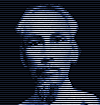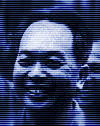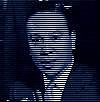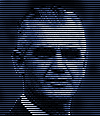- Time Capsule
- Important Faces
- Tet Offensive

Leaders of the Vietnam War
He left his family at an early age and at 21, set out on almost 30 years of
traveling around France, England, Russia, China, Thailand and the United
States, learning to speak French, English, Russian and Chinese fluently. He settled in Paris
where he joined the French Communist Party in 1920 and was later commissioned by Moscow to form a
Marxist-Leninist revolutionary organization in French Indochina. He embraced communism, as this seemed to
be the best way to establish an independent Vietnam.
Early in 1941, he crossed from China into Vietnam where he met with several colleagues with whom he formed the
Vietnamese Independence League. He then adopted his last pseudonym, Ho Chi Minh, which translates into
"Light-Bringer". During 1946, Ho Chi Minh desperately sought to avoid hostilities but the conflict with the French
could not be solved and he began to prepare for war together with General Vo Nguyen Giap, the leader of the
North Vietnamese army. The French were eventually overrun and defeated at Dien Bien Phu in May 1954. Ho
Chi Minh's position as president of the Democratic Republic of Vietnam was confirmed in the constitution of
1959, but his health was failing and by mid 1960, his role in decision making was mainly ceremonial.
Ho Chi Minh was considered to be both a patriot and a Marxist-Leninist who saw no contradiction between the two
positions and controversy often stirred in regard to his stance as a patriot or a communist. He was capable of
great charm, but also of being ruthless in his tactics to achieve his goals. He was considered a gifted leader with a
talent for administration, strategy, and being a motivator in the fight for Vietnamese independence. He did not live
to see the fulfillment of his mission; he died on September 2nd 1969, the 24th anniversary of his
declaration of independence for Vietnam.(Back to Top)
General Giap was considered to be one of the most interesting characters of
the Vietnam War. He had received no formal instruction in military science,
but was by no means ignorant of the art of war. He admired Napoleon and
T.E. Lawrence and described himself as a self-taught general. Born in the region close to the DMZ (An Xa) and
attending Quoc Hoc Academy in Hu�, he was expelled following a student strike and later earned a degree in law
at the University of Hanoi, which was a French institution.
Giap's first command was a group of 34 guerillas, which he led to some small victories; at the end of his career he
commanded the world's third largest army and was hailed as the architect of Vietnam's victory. After the French
banned the Communist Party, Giap fled to China where he became a key deputy of Ho Chi Minh and was given
command over the Viet Minh guerrilla forces fighting the Japanese from 1940 to 1945. The Communists seized
control in 1945 and Giap became one of the top figures in the newly formed government.
During the war against the French, Giap shaped the People's Army of Vietnam (PAVN) into a potent fighting
force. His historical reputation results from his victory at Dien Bien Phu in May 1954. Using siege tactics, Giap
defeated the French with an extraordinary logistical buildup and effective use of a well-protected artillery. He achieved
French surrender just days before the Geneva Conference, which would negotiate the French withdrawal from Vietnam,
but would leave the country divided.
In the late 1950's through to the late 1960's, Giap remained a key military figure but became embroiled in a
fierce debate over the strategy for reunification. Eventually this power struggle would lead to the Communist Party
demoting and ridiculing him. In 1967, Giap was the designer of the Tet offensive; this proved to be his last
great military involvement, retiring in 1973 after the failed Ester Offensive. Reportedly suffering from illness, Giap
resigned his position as minister of defense in 1980 and lost his seat in the politburo in 1982, after which he
became chief of the Science and Technology Commission. In July 1992, he was awarded the Gold Star Order,
Vietnam's highest decorative honor.(Back to Top)
During the coup against Diem in 1963, Thieu led one of the attacks on the
presidential palace. He was promoted to brigadier but Thieu was not happy,
as he had expected a higher position within the government. In January 1965, US Government officials
told Prime Minister Tran Van Huong to add Thieu, among others, to his cabinet and he was therefore appointed as
second deputy Prime Minister. Thieu strongly favored the expansion of the military actions against the communists
in the North.
As the US escalated their bombing campaigns in the North, Thieu slowly climbed the ranks as he strongly supported
any US actions. Thieu was appointed to be leader of the military and began using its power to further promote his
standing within the South Vietnamese government. The military would harass people who opposed Thieu and
during the elections in 1965, which Thieu won, they used many unconventional methods in order to obtain votes.
The Thieu regime was a puppet state of the US and internal conflicts and competition over leadership quickly
led to a split in the government, with corruption and a lack of discipline being widespread amongst all ranks. Thieu
held office until April 12th, 1975; the Vietnam War ended the following day.(Back to Top)
General Westmoreland took command in Vietnam in June 1964 replacing Gen.
Paul Harkins. He was instrumental in raising the level of US forces deployed in Vietnam and in developing the
strategies implemented in the region. Westmoreland continuously requested for an increase in manpower in
Vietnam and President Johnson, who had his own troubles at home, refused to send more troops and finally recalled
Westmoreland after he successfully stopped the North Vietnamese Tet Offensive in 1968. He was replaced by
General Creighton W. Abrams
Upon his return to the US, Westmoreland was appointed as Chief of Staff of the US Army. His biggest challenge was
to withdraw the troops from Vietnam and ready them for duty in other regions of the world. He was successful in
restructuring the Army at a difficult time, but his tactics in Vietnam had become unpopular with some groups in the
US. He maintained for many years that the policy in Vietnam had been the right one. General Westmoreland
retired in 1972.
Ho Chi MINH
 1890-1969 (born Nguyen Sinh Cung) Founder of the Vietnamese Communist Party, 1930
1890-1969 (born Nguyen Sinh Cung) Founder of the Vietnamese Communist Party, 1930
Gen. Vo Nguyen Giap
 Born 1911 General and Commander PAVN Politburo Communist Party 1951-1976 Minister of Defence 1946-1980
Born 1911 General and Commander PAVN Politburo Communist Party 1951-1976 Minister of Defence 1946-1980
Nguyen Van Thieu
 Born 1923 Graduated 1948 from Dalat Military Academy Trained in the US 1957 and 1960.
Born 1923 Graduated 1948 from Dalat Military Academy Trained in the US 1957 and 1960.
Gen. William Westmoreland
 Born 1914. Graduated West Point 1936 Served with distinction in WWII Superintendent West Point in 1960
Commander US Military Assistance Command, Vietnam (COMUSMACV) 1964-1968.
Born 1914. Graduated West Point 1936 Served with distinction in WWII Superintendent West Point in 1960
Commander US Military Assistance Command, Vietnam (COMUSMACV) 1964-1968.
